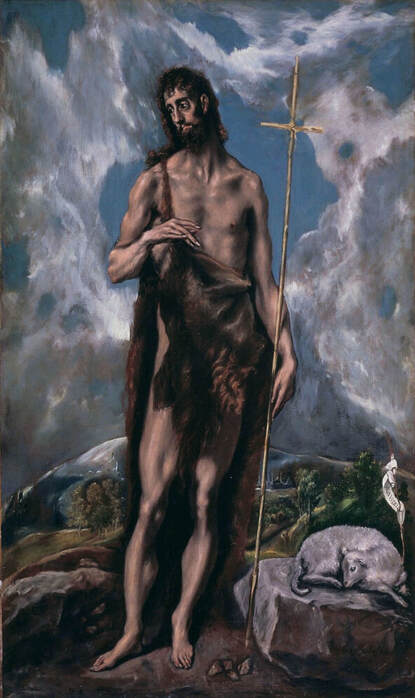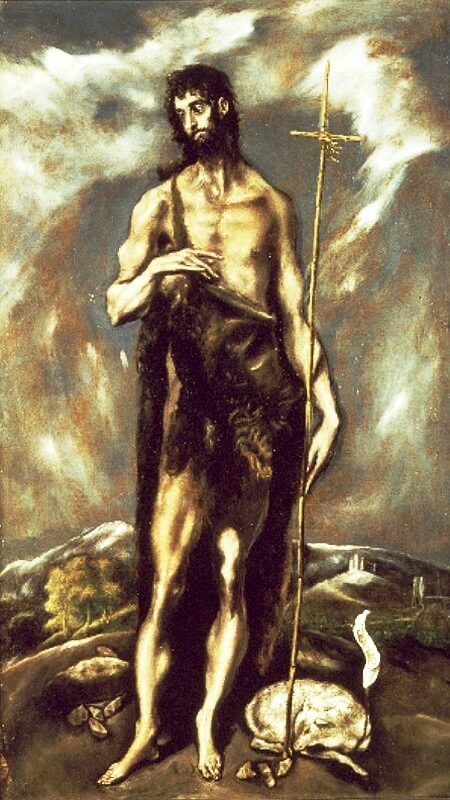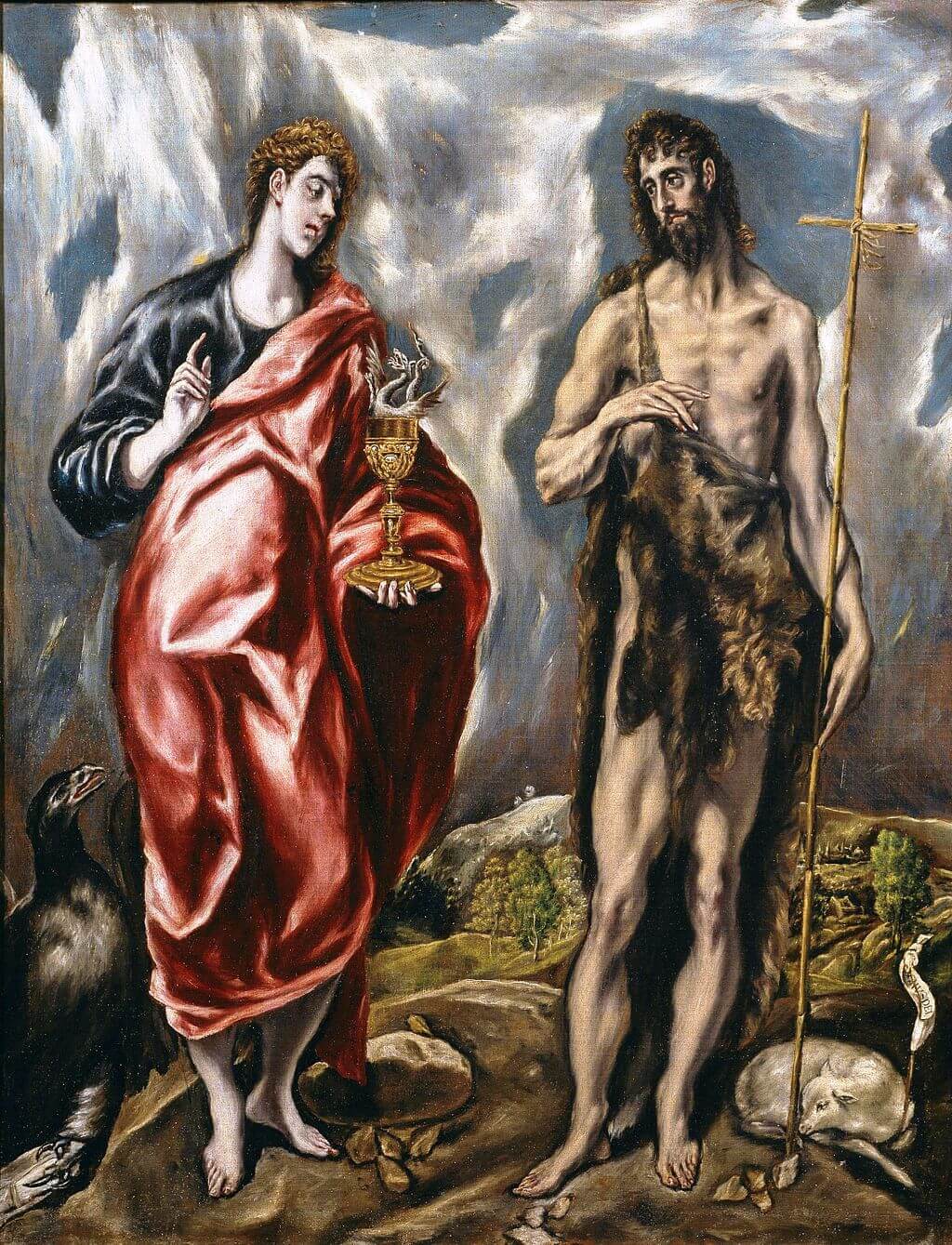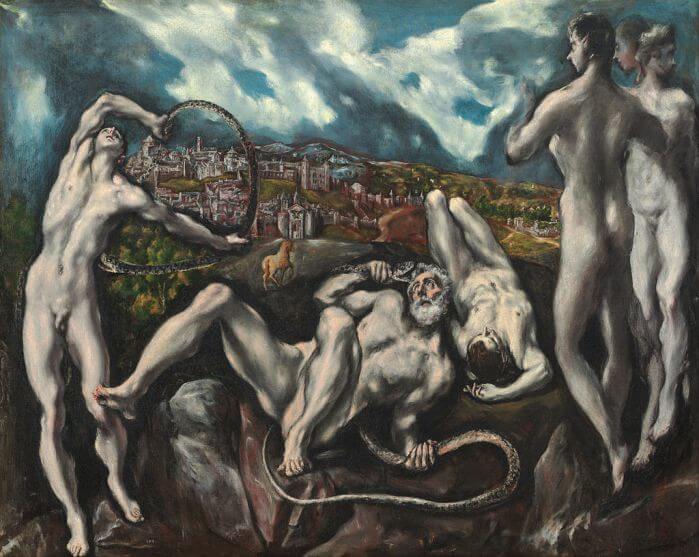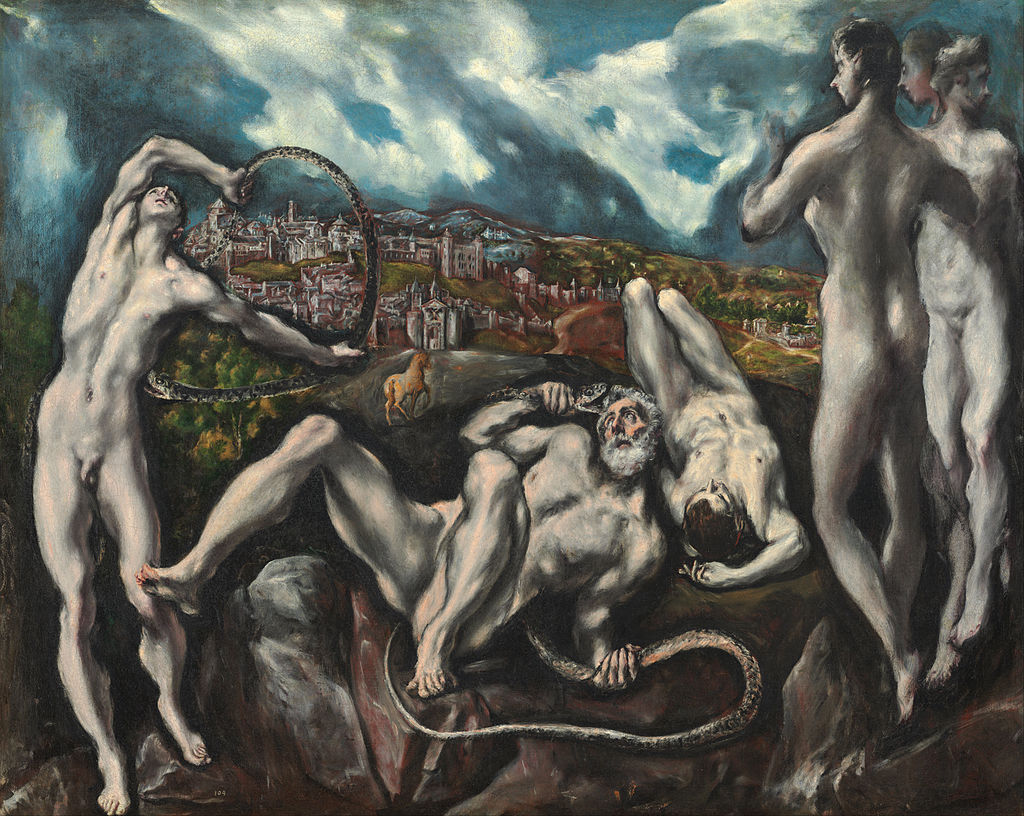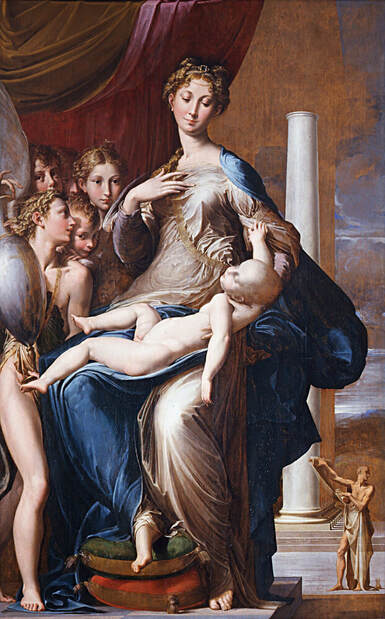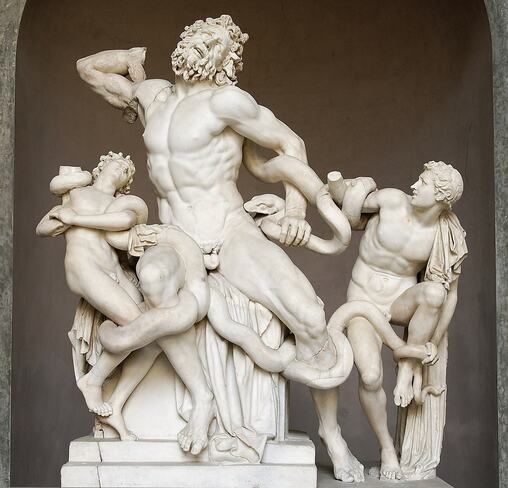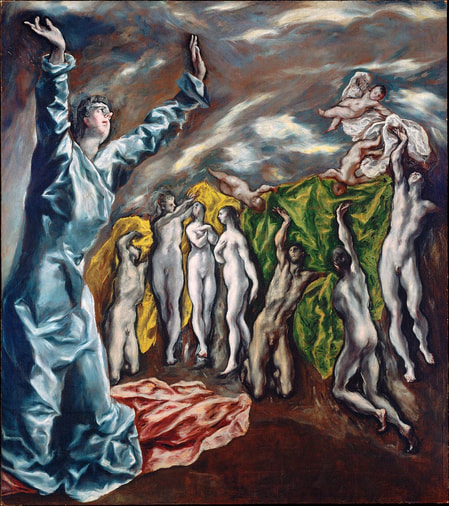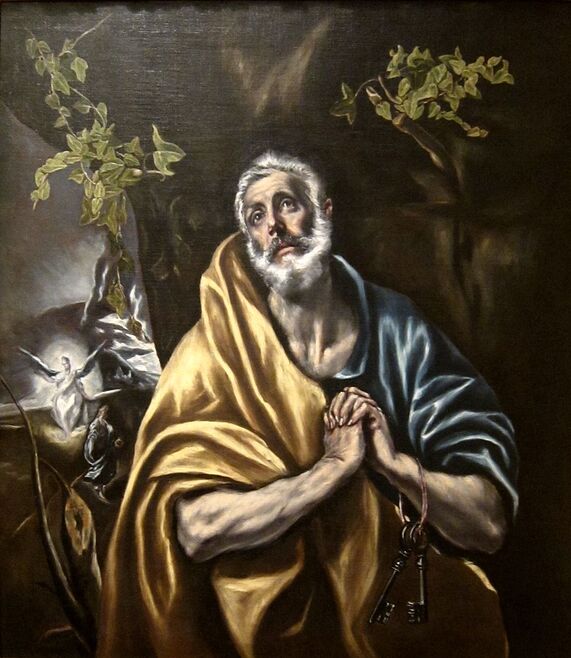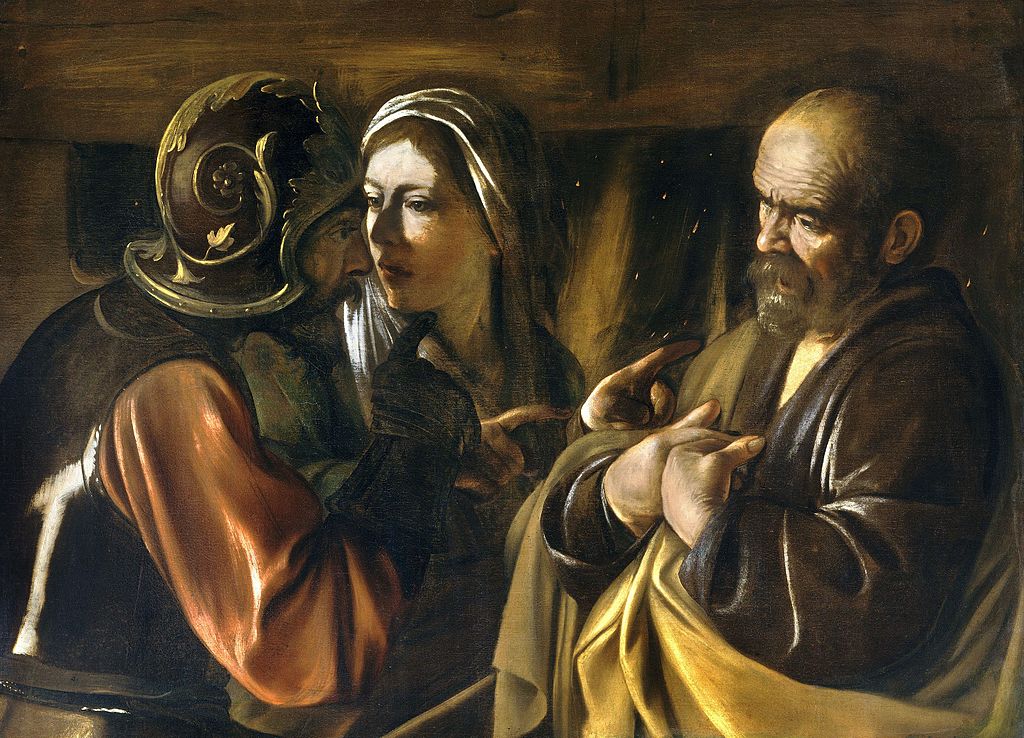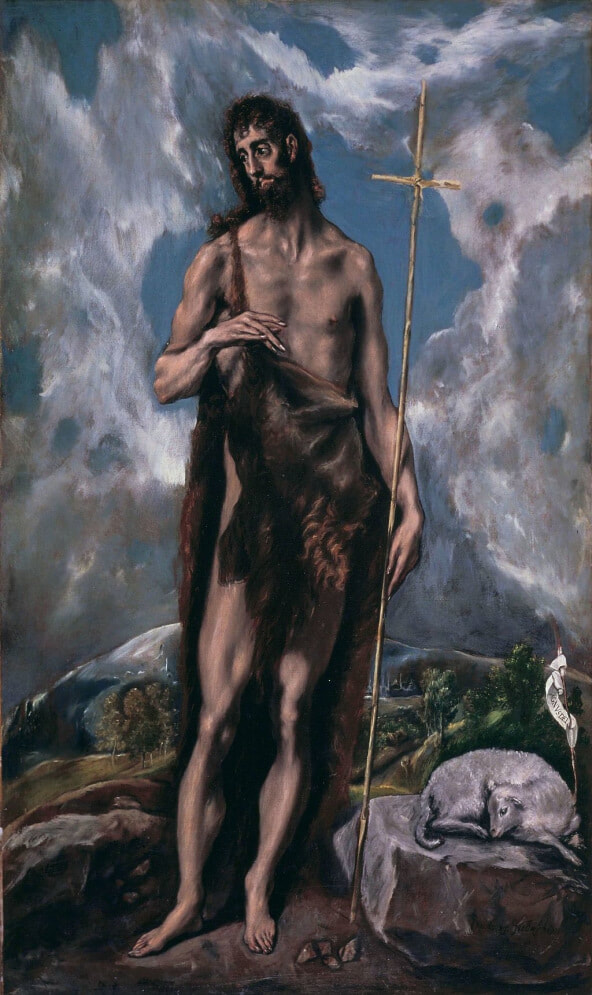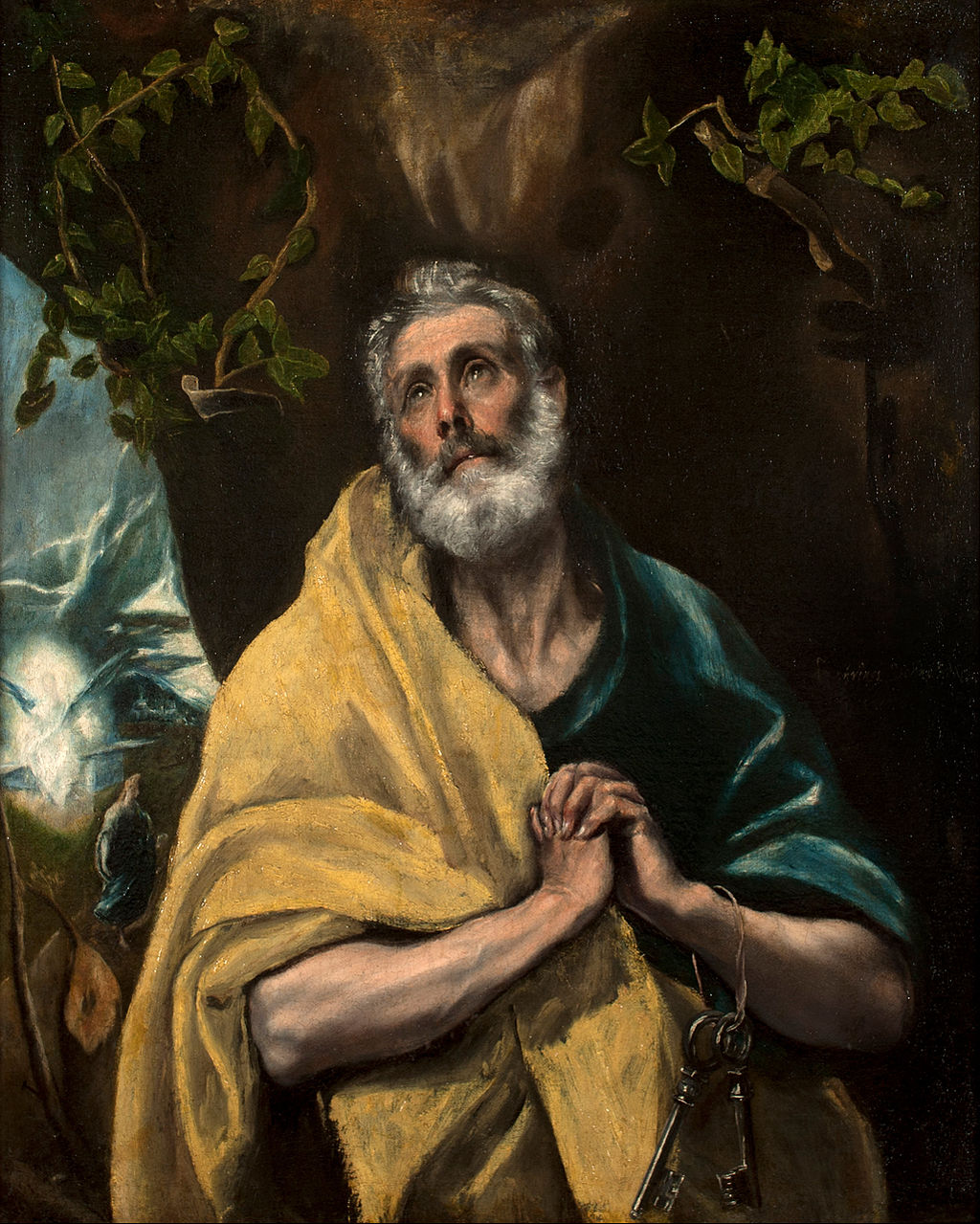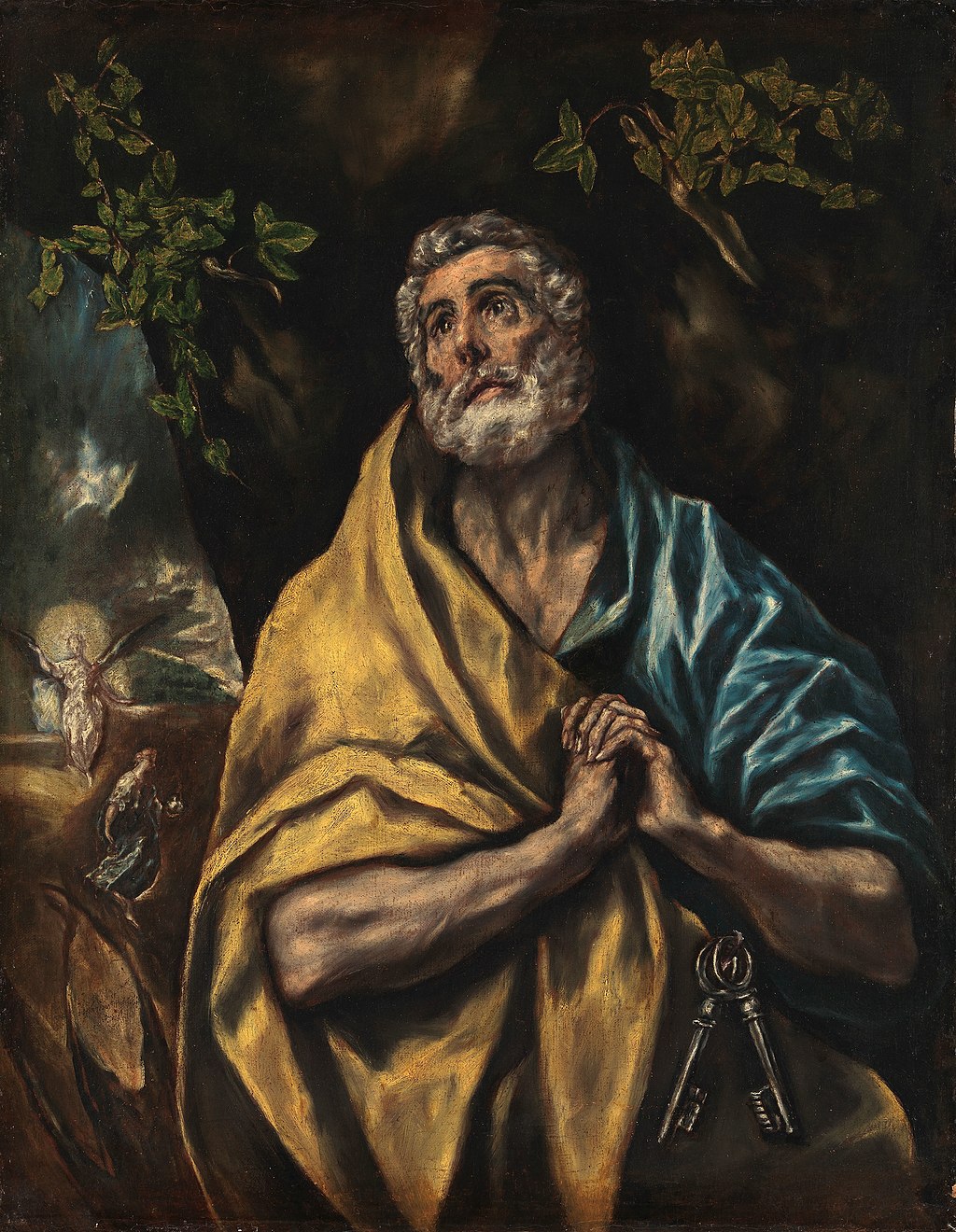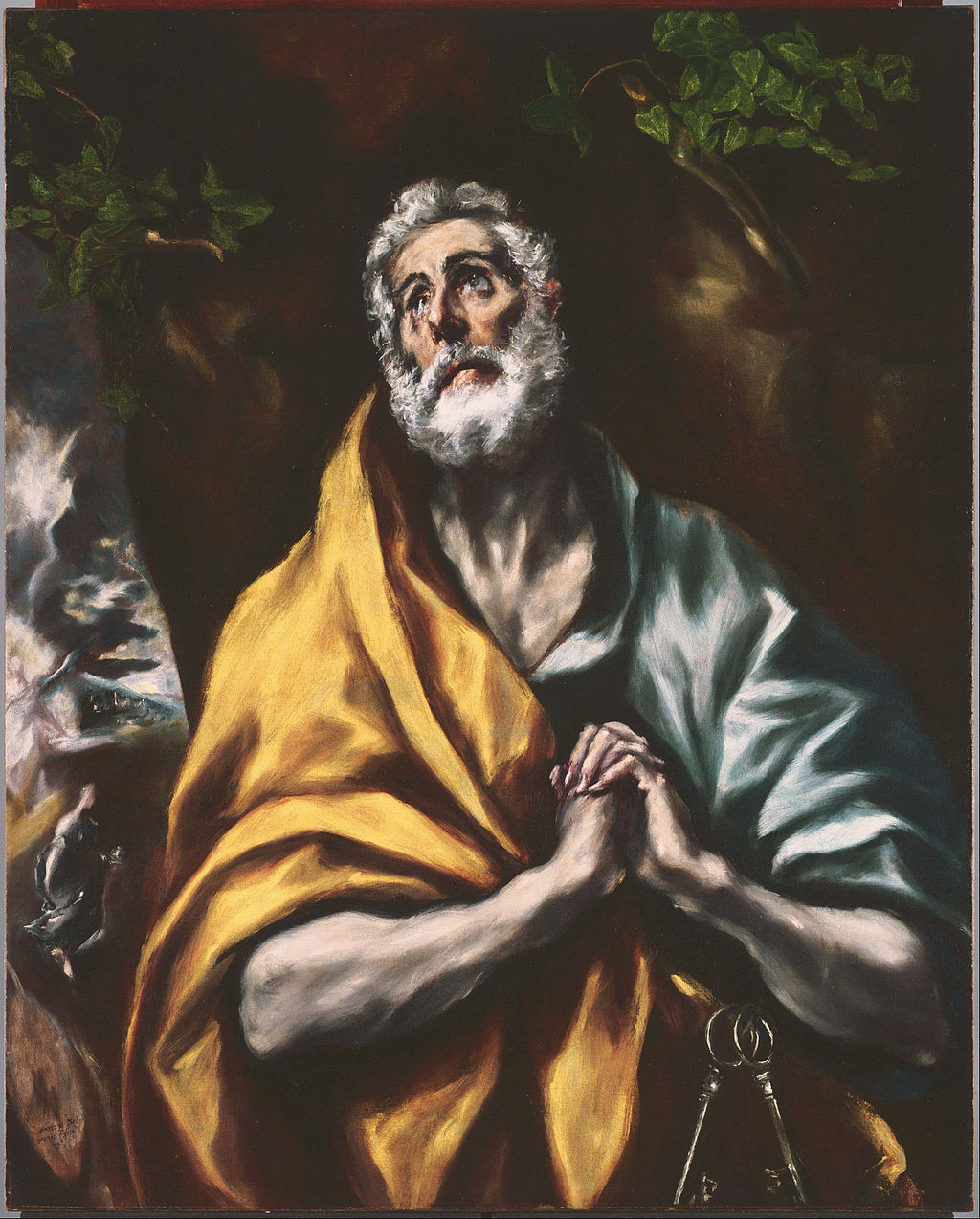|
Where? Gallery 5 of the Legion of Honor Museum
When? Around 1600 Commissioned by? The Convent of the Discalced Carmelites in Malagón, Spain. What do you see? The elongated figure of Saint John the Baptist. He looks unusually tall and thin, typical of the style of El Greco. Saint John the Baptist wears a robe of camel skin, and a long cross stands to his side. On the right, a lamb lies down on a rock. Next to the rock is a stick with a banner reading “AGNUS DEI” (Lamb of God), which is how Saint John the Baptist refers to Jesus in John 1. The Lamb of God refers to Jesus’ role in taking away the sins of the world through his crucifixion (to which the cross explicitly refers). El Greco uses a low horizon and dedicates more than half of the painting to a luminous sky. The bright light from the sky reflects on the hills in the background. El Greco places Saint John the Baptist in the middle of a landscape. The building next to his left knee is the Monasterio del Escorial, a historical residence of the King of Spain located 30 miles outside of Madrid. Backstory: El Greco painted this work while living in Toledo, Spain. The Legion of Honor Museum acquired this painting in 1946. It is displayed next to two other paintings by El Greco in the museum. Other versions: El Greco painted several variations on this painting. A very similar version of Saint John the Baptist is in the Museu de Belles Arts de València. The main difference between both versions is that El Greco worked out some more details in the background of the Legion of Honor version, and he changed the placement of the lamb next to Saint John the Baptist. Another similar version of Saint John the Baptist is owned by the Prado Museum and on display in Toledo. This version shows Saint John the Baptist together with Saint John the Evangelist. For this painting, El Greco used the help of his workshop.
Who is Saint John the Baptist? A preacher who foretold the coming of Jesus. During his life, he baptized many people to wash away their sins. His most important deed was the baptism of Jesus. He is the patron saint of Jordan and Puerto Rico, as well as cities like Florence and Porto.
Who is El Greco? Doménikos Theotokópoulos was born in 1541 in Heraklion, Greece, and died in 1614 in Toledo, Spain. He is better known as El Greco (the Greek). During his twenties and thirties, he spent several years in Italian cities like Venice and Rome, where he got inspiration from artists like Michelangelo, Tintoretto, and Titian. He eventually moved to Toledo, near Madrid. El Greco developed a unique style that is difficult to classify as it was so different from all other painters. He was a Mannerist, he was very expressive, and his works contain some fantasy-like elements. His work has inspired many artists over time, including Delacroix, Manet, and Picasso. He painted both religious and mythological works. An example of the latter is his Laocoön in the National Gallery of Art.
Fun fact: The extremely elongated figures are a recurring theme in the works of El Greco. It is not certain why El Greco used this style, but there are two main explanations.
0 Comments
Where? Gallery 28 of the National Gallery of Art
When? Between 1610 and 1614 What do you see? Laocoön is the bearded man lying down on the dark rocks in the center foreground. He is attacked by a sea serpent (a type of dragon in mythology). He grabs the serpent with both hands, but, nevertheless, the serpent bites him in the head. This serpent has already killed Laocoön’s son who lies to the right of him. On the left side stands the other son of Laocoön. He also struggles to fend off a serpent while the serpent is about to bite him in his abdomen. The three people on the right are unidentified witnesses to the killing of Laocoön and his two sons, though one of them looks away from the scene. They may represent Greek gods who were behind the punishment of Laocoön and his sons, but this is uncertain. The horse behind Laocoön represents the Trojan horse. The horse is on the way to Toledo, the fortified city in the background depicted under a gloomy sky. The entrance gate to the city is directly behind the horse. It is called the Puerta de Bisagra Nueva and still exists. This gate is decorated with a double-headed eagle.
Symbolism: This painting probably contains a deeper meaning. El Greco painted the scene of Laocoön and his sons in front of Toledo, the city where he lived and the former capital of Spain. He painted Toledo instead of Troy, which is the city where the horse is sent according to Greek mythology.
The killing of Laocoön and his sons in this painting takes place on a hill just outside Toledo. This would be the same place where prisoners and people who did not agree with the Catholic Church were executed during that time. The painting of El Greco may have been a protest against these actions. However, there is no substantive evidence to back up this interpretation, so the real meaning of this painting remains speculative. Laocoön and His Sons? According to Greek mythology, Laocoön was a Trojan priest. There are various accounts of his story. Virgil describes the most popular version in the second book of the Aeneid. According to him, when the Greeks left Troy, they left as a gift a very large wooden horse in front of the gates of Troy. Laocoön suspected that this horse was a trick of the Greeks and tried to convince the people of Troy not to accept the gift. To prove that the horse was a trick, he struck the horse with his spear to show that it was hollow. Poseidon and Athena then punished him for his interference and Laocoön and his two sons were attacked and killed by two sea serpents named Porces and Chariboea. The Trojans interpreted this event as a sign that the horse was not a trick and they took the horse into their city walls after which the Greek came out of the horse during the night and defeated the Trojans. A famous statue from antiquity of Laocoön and His Sons is in the Vatican Museums, and a 16th-century copy by Bandinelli is in the Uffizi Museum.
Who is El Greco? Doménikos Theotokópoulos was born in 1541 in Heraklion, Greece, and died in 1614 in Toledo, Spain. He is better known as El Greco, which means ‘the Greek.’ During his twenties and thirties, he spent several years in Italian cities like Venice and Rome, where he got inspiration from artists like Michelangelo and Tintoretto. He eventually moved to Toledo, which is near Madrid. El Greco developed a unique style that is difficult to classify as it was so different from all other painters. He was a Mannerist, he was very expressive, and his work included some fantasy-like elements. His work has inspired many artists over time, including Delacroix, Manet, and Picasso.
Fun fact: El Greco often included nude figures in his paintings. While in the current painting, nudity is somewhat functional as it is based on a mythological story in which people were often depicted nude, he also often included nude figures in his religious paintings. A good example is The Vision of Saint John in the Metropolitan Museum of Art. Interestingly, El Greco grew up in Greece where he was exposed to Byzantine art which contained very little nudity. However, he got inspired by the nude figures painted by Michelangelo and other Renaissance artists during his travels through Italy in the 1560s and 1570s. Interested in a copy for yourself? Poster
Where? Room 16 of the San Diego Museum of Art
When? c. 1590-1595 Commissioned by? Unknown What do you see? Saint Peter has his hands folded and looks up to the sky. He has just denied his relation with Jesus three times and severely regrets these denials. He had promised Jesus that he would not deny him and now seeks forgiveness for his actions. He is outside in front of a tree, which is a quiet place where he can express his sorrows. We can recognize Saint Peter by several of his attributes. He has his iconic white bushy hair and beard, and he has the Keys of Heaven around his left arm. El Greco also painted Saint Peter with a characteristic golden robe on top of a blue garment. By using luminous colors for these garments and exaggerating certain features, like the long neck, El Greco succeeded in creating a dramatic, eye-catching image of the repentant Saint Peter. Small scene on the left: On the left, next to the large tree, is another scene. It shows Mary Magdalene returning from the grave of Jesus. We can recognize her by the jar of ointment in her left hand. In front of the grave stands a luminous angel. Mary Magdalene has just discovered that the grave of Jesus was empty and hurries away to tell the news that Jesus was resurrected to Saint Peter and the other disciples. Saint Peter’s Denial: This painting is based on the Biblical stories on Saint Peter denying Jesus three times. The stories are described in the Gospels of Matthew 26, Mark 14, Luke 22, John 13, and John 18. During the Last Supper, just before his crucifixion, Jesus told Peter that he would disown Him three times before the rooster would crow. Saint Peter immediately responded to Jesus by saying that he would never deny his relation with Him. But before dawn, Peter did actually deny Jesus three times. Immediately after the third denial, the rooster crowed for the second time, and Peter realized what he had done. He regretted his actions and started to cry as he realized that Jesus was right with his prediction. The denial of Saint Peter and his repentance have inspired various artists over time. Among them is Caravaggio who painted The Denial of Saint Peter in the Metropolitan Museum of Art.
Backstory: The subject of Saint Peter’s repentance was a popular one in the 16th and 17th century in Catholic countries like Italy and Spain. The Catholic Church wanted to promote the idea of repentance to the people. As people, including Saint Peter, naturally makes mistakes, the Church wanted to let people know that they could admit to their sins and ask God for forgiveness.
Restoration: Initially, this painting in the San Diego Museum of Art only showed the main scene on the penitent Saint Peter. But by comparing this work with similar versions (see below) of this work by El Greco, they suspected that there also had to be a smaller scene on the left side of the painting. Indeed, after a thorough cleaning of the painting, the small scene with Mary Magdelene was discovered. Who is El Greco? Doménikos Theotokópoulos, better known as El Greco, was born in 1541 on the Greek island of Crete. During his youth, he learned about the Byzantine Art that was popular in Greece. When he was 27 years old, he moved to Italy and spent several years in cities like Venice and Rome. Here, he became familiar with Renaissance Art and the works of painters like Michelangelo, Tintoretto, and Titian. In 1577, he moved to Toledo, Spain, where he would spend the rest of his life. He combined his early training in Byzantine Art with the things he learned in Italy to create his own unique style. His use of colors and the strongly elongated features of his subjects distinguish his work from any other artist. Among his works are Laocoön in the National Gallery of Art and Saint John the Baptist in the Legion of Honor Museum.
Fun fact: The subject of Saint Peter’s penitence was close to El Greco’s heart. He painted at least six other versions of this subject which are spread across the world. Two versions are in Toledo, Spain, in the El Greco Museum and the Museo Fundación Lerma. Other versions can be found in the Bowes Museum in England, the Museo Soumaya in Mexico City, the National Gallery of Norway, and the Phillips Collection in Washington.
|
Categories
All
|
- Home
- Blog
-
Museums
- Alte Pinakothek
- Art Institute of Chicago
- Baltimore Museum of Art
- Barber Institute of Fine Arts
- Bargello
- Barnes Foundation
- British Museum
- Church of Sant’Anastasia
- Cleveland Museum of Art
- Courtauld Institute of Art
- Detroit Institute of Arts
- Frans Hals Museum
- Galleria Borghese
- Gallerie dell'Accademia
- Getty Museum
- Guggenheim
- Hermitage Museum
- Kunsthistorisches Museum
- Kunstmuseum Basel
- Legion of Honor Museum
- Louvre
- Mauritshuis
- Metropolitan Museum of Art
- Musee d’Orsay
- Museum of Fine Arts in Boston
- Museum of Modern Art
- National Gallery in London
- National Gallery of Art
- National Museum in Poznań
- Norton Simon Museum
- Ny Carlsberg Glyptotek
- Palace of Versailles
- Palazzo Pitti
- Palazzo Vecchio
- Petit Palais
- Philadelphia Museum of Art
- Prado
- Pushkin Museum
- Ravenna Art Museum
- Rijksmuseum
- San Diego Museum of Art
- Santa Maria delle Grazie
- St. Peter's Basilica
- Städel Museum
- Statens Museum for Kunst
- Tate Britain
- Tate Modern
- Timken Museum of Art
- Uffizi
- Vatican Museums
- Wallace Collection
-
Artists
- Altdorfer
- Anguissola
- Berlin Painter
- Bosch
- Botticelli
- Boucher
- Bronzino
- Bruegel the Elder
- Brunelleschi
- Cabanel
- Caillebotte
- Canova
- Caravaggio
- Carpeaux
- Cezanne
- Cimabue
- David
- Degas
- Delacroix
- De Maria
- Donatello
- El Greco
- Fontana
- Fra Angelico
- Fragonard
- Gauguin
- Gentileschi
- Gericault
- Gonzalez-Torres
- Goya
- Hals
- Hogarth
- Hokusai
- Ingres
- Leonardo da Vinci
- Lippi, Filippo
- Longhi, Barbara
- Lorrain
- Makovsky
- Manet
- Massys
- Matisse
- Merian
- Michelangelo
- Mochi
- Modigliani
- Monet
- Panini
- Parmigianino
- Perugino
- Picasso
- Pisanello
- Raphael
- Rembrandt
- Renoir
- Reynolds
- Rivera
- Rodin
- Rubens
- Scultori
- Seurat
- Steen
- Tintoretto
- Titian
- Toulouse-Lautrec
- Turner
- Uccello
- Van der Weyden
- Van Dyck
- Van Eyck
- Van Gogh
- Van Hemessen
- Vasari
- Velazquez
- Vermeer
- Veronese
- Vigée Le Brun
-
Locations
- Books
- About Us

